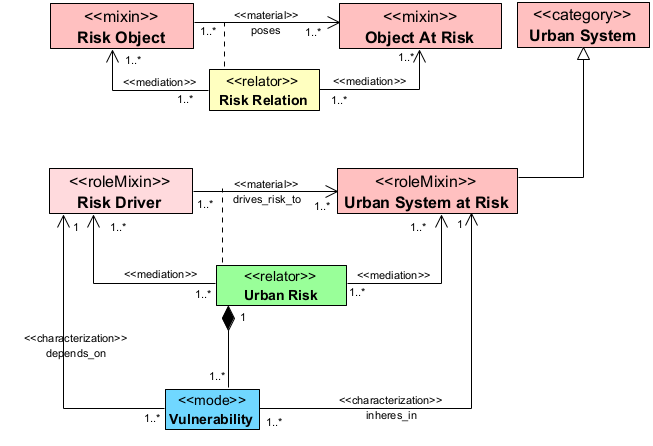|
|
|
Fragment_RiskDriverXObjectAtRisk : Package
Class Diagram - Fragment_RiskDriverAndObjectAtRisk
![]() link
link
| Jump to: |

|
| Model Elements |
| Name | Description | ||
|
|
An object at risk is any agentive or non-agentive object that is exposed to a hazardous situation or is vulnerable to certain hazardous situations. |
||
|
|
1. [IPCC] Any natural or human-induced factor that directly or indirectly causes a change in a system (adapted from MA, 2005).
2. It encompasses both natural and human-induced factors, processes, or conditions that result in a direct or indirect alteration of a system.
Available at: https://civil-protection-knowledge-network.europa.eu/eu-overview-risks |
||
|
|
The Risk Object is considered, under certain contingent circumstances and
in some causal way, to pose a threat to the valued object at risk.
Source: Åsa Boholm & Hervé Corvellec, 2011. "A relational theory of risk," Journal of Risk Research, Taylor & Francis Journals, vol. 14(2), pages 175-190, February.
In risk-oriented urban systems, a risk object is specialized as a Risk Driver. |
||
|
|
|||
|
|
It is a relational structure that links Risk Drivers and Urban Systems at Risk.
In the case of urban systems, risks are assessed
based on two different types of phenomena: 1) natural phenomena; and 2)
man-made phenomena. Natural phenomena are events that do not have a
human cause; examples include earthquakes, tsunamis, and solar storms.
Conversely, human phenomena are events caused by human action. For
example, pollution, urbanization, extensive monoculture, and
deforestation. [IPCC] Risk is defined by IPCC v.6 as the potential for adverse consequences for human or ecological systems, recognizing the diversity of values and objectives associated with such systems.
In the context of climate change, risks can arise from potential impacts of climate change as well as human responses to climate change. Relevant adverse consequences include those on lives, livelihoods, health and well-being, economic, social and cultural assets and investments, infrastructure, services (including ecosystem services), ecosystems and species.
In the context of climate change impacts, risks result from dynamic interactions between climate-related hazards with the exposure and vulnerability of the affected human or ecological system to the hazards. Hazards, exposure and vulnerability may each be subject to uncertainty in terms of magnitude and likelihood of occurrence, and each may change over time and space due to socio-economic changes and human decision-making (see also risk management, adaptation and mitigation).
In the context of climate change responses, risks result from the potential for such responses not achieving the intended objective(s), or from potential trade-offs with, or negative side-effects on, other societal objectives, such as the Sustainable Development Goals (SDGs) (see also risk trade-off). Risks can arise, for example, from uncertainty in implementation, effectiveness or outcomes of climate policy, climate-related investments, technology development or adoption, and system transitions.
Source: https://www.ipcc.ch/site/assets/uploads/2021/02/Risk-guidance-FINAL_15Feb2021.pdf |
||
|
|
An Urban System is a human-made system placed in a specific space and time. It is composed of essential parts, which are Infrastructure, Geosphere, and Population. Population is a collective of agents who live or use the urban space and the tangible Infrastructure (hard infrastructure) through services (soft infrastructure). In turn, the Urban Space (Geosphere) is the territory, the place where the population (resident or non-resident) lives or uses the soil as well as where the infrastructure is located. |
||
|
|
An urban system is a set of interconnected parts (population, urban space, and infrastructure). An urban system at risk has one or more parts vulnerable or exposed to certain risk drivers in certain situations. |
||
|
|
The propensity or predisposition to be adversely affected. Vulnerability encompasses a variety of concepts and elements, including sensitivity or susceptibility to harm and lack of capacity to cope and adapt.
Vulnerability expresses the relationship between the intensity of an adverse event, the features of the elements at risk (assets, community, system, environment) that affect their behavior, and the measure of the damage resulting from the event (response). Uncertainty in assessing vulnerability is due to insufficient knowledge of the features affecting the response and the possible effects on the elements exposed to an event.
Vulnerability is defined in different ways depending on the types of risk being assessed. In seismic risks, vulnerability is the probability that an element at risk, belonging to a specific behavioral class (vulnerability class), experiences or exceeds a damage threshold (according to a predetermined scale of damage) upon the occurrence of an event of an assigned intensity. In flood risks, vulnerability expresses the expected damage to the elements at risk, the extent of damage ranging from 0 (no damage) to 1 (total destruction). |
||